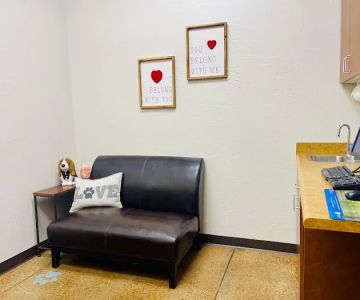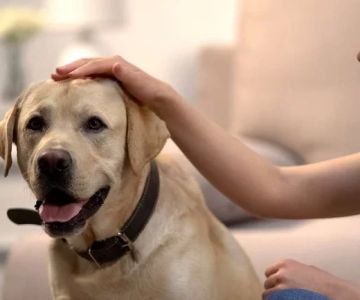- 1 - Understanding Noise Stress in Dogs
- 2 - Training Your Dog to Handle Noises
- 3 - Tools and Techniques for Noise Training
- 4 - Gradual Exposure to Loud Sounds
- 5 - Case Studies and Real-World Examples
- 6 - How Hidden Brook Veterinary Can Help
1 - Understanding Noise Stress in Dogs
Noise stress in dogs is a common issue that can stem from loud sounds like thunderstorms, fireworks, or even the hustle and bustle of city life. Some dogs are more sensitive to noise than others, leading to anxiety, fear, or even destructive behaviors. Understanding the triggers and symptoms of noise stress is the first step in helping your dog cope with these situations.
1.1 - How Dogs React to Loud Noises
Dogs can experience a variety of reactions when exposed to loud sounds. These may include hiding, trembling, excessive barking, drooling, or trying to escape the noise. In more extreme cases, noise phobia can lead to destructive behavior such as chewing on furniture or injuring themselves in an attempt to escape the sound.
1.2 - The Science Behind Noise Sensitivity
While some dogs are naturally more sensitive to noises, factors like genetics, early experiences, and lack of exposure to sounds during puppyhood can play a role in the development of noise stress. Dogs have far superior hearing than humans, and sounds that we might consider normal can be overwhelming or frightening to them.
2 - Training Your Dog to Handle Noises
Training your dog to handle noisy environments involves gradual desensitization and positive reinforcement. The goal is to make your dog feel safe and relaxed when exposed to sounds that previously caused fear or anxiety. By using a combination of patience, consistency, and rewards, you can help your dog become more comfortable in noisy situations.
2.1 - Start with Low-Volume Sounds
Begin by exposing your dog to low-volume noises in a controlled environment. This could include recordings of thunderstorms, fireworks, or traffic sounds played at a low volume. Gradually increase the volume as your dog becomes more comfortable with the sound.
2.2 - Reward Calm Behavior
Whenever your dog remains calm during exposure to the noise, immediately reward them with treats or praise. Positive reinforcement helps your dog associate the sound with something pleasant, reducing their anxiety over time.
2.3 - Use Distractions
Introduce distractions like toys or interactive games to keep your dog’s attention focused on something other than the noise. Engaging them in an activity can help them feel less stressed and more in control of their environment.
3 - Tools and Techniques for Noise Training
In addition to gradual desensitization, several tools and techniques can help you train your dog to handle noisy environments. These methods can be combined for more effective results, depending on your dog’s specific needs and temperament.
3.1 - Sound Machines and Noise Recordings
Sound machines or recordings of calming noises such as white noise, nature sounds, or soft music can help mask loud or unexpected sounds. Using these tools can help your dog feel less overwhelmed by external noise while you work on desensitization.
3.2 - Thundershirts and Anxiety Wraps
Thundershirts and anxiety wraps are designed to apply gentle pressure to your dog’s body, which has been shown to have a calming effect. These can be particularly helpful during thunderstorms or fireworks displays, offering your dog a sense of security.
3.3 - Behavior Modification Techniques
Some dogs may benefit from professional training or behavior modification. Techniques such as counter-conditioning and desensitization, when used by experienced trainers, can speed up the process of helping your dog cope with noisy environments.
4 - Gradual Exposure to Loud Sounds
Gradual exposure is one of the most effective methods for helping your dog become comfortable with noisy environments. The key is to start slowly and progressively increase the intensity of the sound.
4.1 - Step 1: Begin with Low Levels
Start by playing sounds at a very low level—just loud enough for your dog to hear but not to react. Let them listen to the noise for short periods, gradually increasing the length of time as they become more accustomed to it.
4.2 - Step 2: Increase the Volume Gradually
Once your dog is comfortable with low-level noises, slowly increase the volume. Make sure you do this in small increments to avoid overwhelming your dog. Always reward calm behavior during each session.
4.3 - Step 3: Simulate Real-Life Scenarios
As your dog becomes more comfortable, simulate real-life scenarios. For example, take them on walks during busy times with lots of traffic or play recordings of loud noises at home, like a doorbell or vacuum. Over time, they will learn to associate these sounds with calm, everyday situations.
5 - Case Studies and Real-World Examples
Real-life examples of dogs successfully overcoming noise stress can provide valuable insights into the process. Many dog owners have shared their success stories after implementing noise training techniques.
5.1 - Case Study 1: Max the Rescue Dog
Max, a rescue dog, was terrified of thunderstorms. His owner, Sarah, gradually exposed him to recorded thunder sounds, starting at a very low volume. After several weeks of consistent training, Max was able to stay calm during storms, with Sarah rewarding him each time he remained composed.
5.2 - Case Study 2: Bella the City Dog
Bella, a city dog, was anxious around traffic and loud city sounds. Her owner, Jason, started walking her during quieter hours, gradually moving to busier streets. Bella’s confidence grew as she was exposed to the city’s sounds at a manageable pace, and now she walks calmly through bustling city blocks.
6 - How Hidden Brook Veterinary Can Help
At Hidden Brook Veterinary, we understand how noise stress can impact your dog’s well-being. Our team offers a range of services, from behavior consultations to training resources, to help your dog overcome noise anxiety. Whether you’re dealing with thunder phobia or city noise stress, we can provide expert advice and tailored solutions to improve your dog’s quality of life. Contact us today for personalized support on your dog’s noise training journey!











